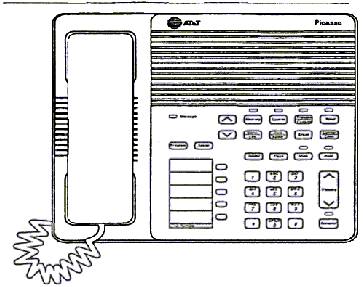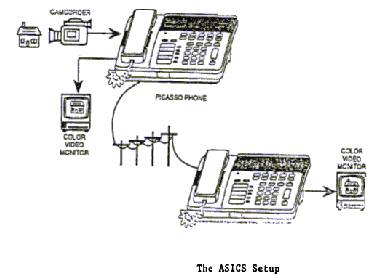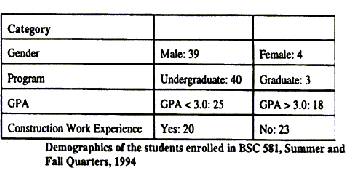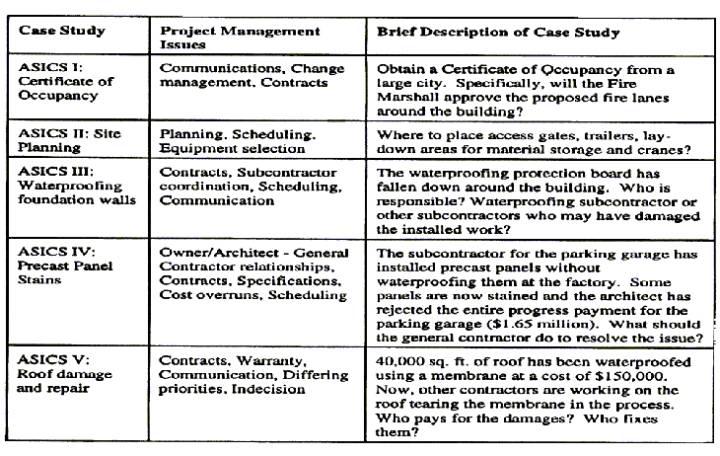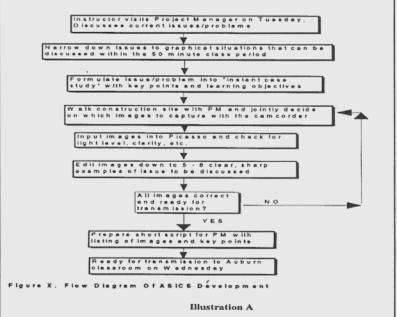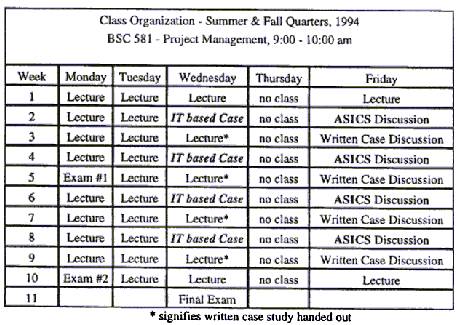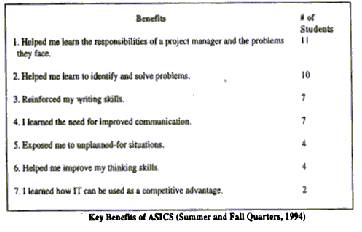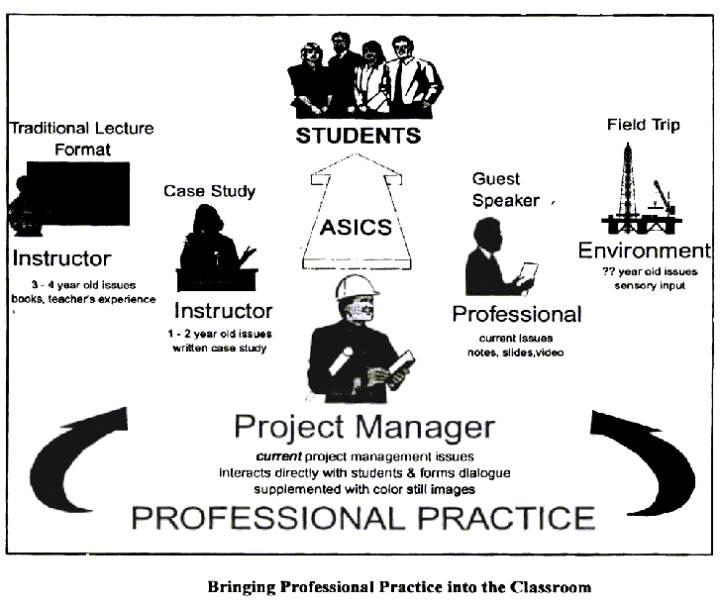|
(pressing HOME will start a new search)
|
|
A Pedagogical Approach in Using Information Technology to Enhance Cognitive Learning
Scott
W. Kramer, Chetan S. Sankar, and Kamal Hingorani
Auburn
University
Auburn,
Alabama
|
Educating students about professional practice, namely project management, has long been recognized as an important component of construction education. Information technology provides exciting possibilities for bringing actual project managers to the classroom electronically. In this paper, we describe the use of Annotated Still Image Case Study (ASICS) in a senior undergraduate project management class. A project manager, of a nine-story office building, discussed with the students images that depicted real-time project management issues. The project manager discussed these issues interactively with the students by using a picture phone at the construction site. The students listed the major benefits of ASICS as: identifying and solving project management problems, reinforcing writing skills and learning the need to communicate effectively. Keywords:
Project
Management, Information Technology, Cognitive Skills, Undergraduate
Education, Case Studies. |
Introduction
Project Management Class
Project
management has always been an important topic in construction education,
however, it has taken on increasing importance as organizations downsize,
emphasize quality, and encourage global competition. Instructors of project
management courses generally use the lecture approach and tend to concentrate
on the tools of project management and not emphasize the managerial aspects.
Also, it is easier to teach and grade the tools (such as CPM, cost control,
documentation, etc.) since they teach domain-specific knowledge. Teaching the
managerial aspects of project management requires the instructor to be aware
of real-world issues and communicate them to the students effectively. Some of
the specific managerial issues that need to be taught include: resolving
conflicts, anticipating schedule delays, deciding among differing priorities,
tolerating client interference, managing insufficient funding, living with
indecision, predicting cost overruns, working with inadequate specifications,
and overcoming poor communications.
Teaching
these managerial issues require the instructor to engage the students in using
their cognitive skills such as reasoning, critical thinking, problem solving
and problem identification. Therefore, an innovative teaching method was
developed in order to bring more of the managerial issues into a project
management course. This paper describes this Annotated Still Image Case Study
(ASICS) pedagogy and the benefits of applying this method over two quarters of
instruction.
ASICS and Its Unique Features
Still
image transfer, an inexpensive form of video teleconferencing, provided a new
opportunity to bring real-world issues to the classroom. ASICS required a
picture phone at the project manager's site and another in the classroom (see
Figures I and 2). Images of the real-life issue (for example, damaged
waterproofing) were captured using a camcorder at the construction site. The
freeze-framed images of the video were input into the picture phone at the
site and transmitted over regular phone lines to another picture phone in the
classroom. The images were then magnified in the classroom onto an eight foot
(8') projection screen. An annotating device (mouse) was attached to both
picture phones so that the project manager and the students could circle and
draw on the images similar to a PC paint program. Also, the project manager
and the students could discuss the case interactively by using a built-in
speaker on the picture phones.
|
|
|
Figure
1 |
|
|
|
Figure
2. |
The
unique feature of ASICS was the ability to present case studies on issues of
importance to the project manager as they were currently happening at the
site. This communicated a sense of urgency and the need to cooperate in
resolving the issues among the multiple parties at the site.
The
students were engaged in active learning since they learned directly from the
experiences of a project manager at the site. It also resulted in taking a well
accepted teaching method in the College of Business, case studies, to a Building
Science department and modifying the case method to make it instantaneous and
Information Technology (IT) based. Thus, using two picture phones, we were able
to readopt the original 1908 Harvard Business School case study approach by
bringing a manager to the classroom electronically.
Level of Students
The
students were enrolled in BSC 581, Project Management, a senior-level required
undergraduate class in the Building Science department at Auburn University.
Table 1 shows the demographics of the forty-three (43) students taking the class
Summer and Fall quarters, 1994.
Technical
prerequisites for this course include: concrete and steel design, surveying,
estimating I & II, CPM scheduling, construction law, contracting business
and computers in construction. These prerequisites allowed ASICS to work
effectively because the domain specific knowledge used by the students to
analyze the case studies was already taught in previous course work. Therefore,
the instructor had more freedom in creating ASICS because the case study did not
have to coincide with the theory being taught that week in class.
Discussion
Course Content
Construction
science programs produce many graduates who will eventually become project
managers of construction projects. The construction industry accounts for
approximately 10% of the United States' Gross Domestic Product (GDP) and is a
major predictor of growth or slowdown in the economy. It is labor intensive and
is also
well
known for its conservatism in adopting technologies to increase its
productivity. The productivity growth rate of this industry from 1948 to 1981
was only 15%, as compared to 132% for the manufacturing industry (Ioannou et
al., 1993). Furthermore, it takes approximately 17 years from the
proof-of-feasibility to the adoption of new technology in the construction
industry (Fenves, 1990).
|
|
|
Table
1. |
Better
educated students and students exposed to new information technologies could
become a catalyst for changing the construction industry. Therefore, the authors
chose to experiment with using Information Technology in a senior level
undergraduate class. BSC 581, Project Management, was chosen for the experiment.
Project management situations provide a blend of technical and behavioral issues
and it has been estimated that behavioral issues in project management are
sometimes as high as 75% (Dinsmore, 1990). Therefore, the main objective of
using IT in the classroom was to expose the students to typical management
issues faced by a construction project manager. In addition, the course learning
objectives contained domain specific knowledge such as documentation, change
orders, pay requests and cost control.
The
content of each ASICS was different and unique to the project management issue
being addressed. The learning experience offered by ASICS was through contact
with a project manager at a real construction site and the opportunity to solve
real-life problems. Five different ASICS were presented during the 1994 Summer
and Fall quarters (only four were presented per quarter) and Table 2 summarizes
these case studies.
|
|
|
Table
2. |
Course Organization
As
is typical in most universities, classes in the department of Building Science
are usually taught in the lecture mode and supplemented with slides, videos,
overheads and computer generated displays. In BSC 581, a concerted effort was
made to change the course outline and syllabus in order to incorporate case
method
teaching
(written and IT based) into this particular class. The "instant cases"
that IT provided worked extremely well because the cases did not have to
correlate exactly with the theory being taught that week in the lecture mode.
Because the students had previously taken all required courses except one, they
drew upon a large body of class knowledge. This domain specific knowledge
provided the students with the skills needed to analyze project management
issues. Therefore, the discussions with the project manager went one step
further, and were used to explore and enhance the students' cognitive thinking
skills, such as reasoning and problem solving.
A
flow chart illustrating the structure used to create each ASICS is shown as
Illustration A. It shows that the instructor had to meet with the project
manager one day preceding the ASICS presentation. They had to pick the issue
that would be discussed the next day and capture the necessary images onto a
camcorder. The next day, a student worker helped set up the Picasso phone at the
site, whereas the instructor set up the phone in the classroom. The technology
itself worked consistently well during the classes when ASICS was presented.
|
|
|
Illustration
A. |
The
class periods were arranged according toTable3. Because of the project manager's
jobsite time commitments, Wednesday was the only day that ASICS could be
presented. Therefore, the instructor had to go to the jobsite on Tuesday and
shoot the video clips, load the still images and have the Picasso Phone ready
for the project manager to use on Wednesday. Since BSC-581 is a four credit
class, it did not meet on Thursdays. This proved to be very beneficial for the
students because it gave them time to analyze the cases and write their
recommendations in time for Friday's class. On Friday the instructor collected
one page memos from the students that summarized the project management issue
and outlined specific solutions for solving the problem. Also on Friday, the
instructor discussed the case (written or ASICS) with the students. The
discussions were often lively because the students would take different
viewpoints and defend them in class.
|
|
|
Table
3. |
Presentation
In
order to understand a typical class presentation using ASICS, the different
components of the presentation need to be explained. The different parts include
the picture phone, the construction site and the physical layout of the
classroom.
Picture
phone: The AT&T Picasso Phone (Figure 1) can send/receive color still images
and audio over normal analog telephone lines. Besides sending/receiving color
images and audio, the device allows both the sender and the receiver to draw on
the displayed image simultaneously using a mouse as a pointing device. In this
way, both parties can make sure that they are looking at and discussing the same
area of the image. This is extremely valuable when discussing complex structural
images or large plan views of the site. There are three integral parts to the
system; a camcorder that initially captures the images, a Picasso Phone which
stores/transmits/receives the images, and a color TV monitor that displays the
images. The images to be transmitted are first recorded onto a video tape using
the
camcorder
and then input into the Picasso phone using a S video cable. The Picasso's
preview/capture button freezes a single frame of the video and allows the user
to store the still image into memory (RAM), retrieve it later, and transmit it
to the receiving unit when needed. The Picasso can store up to 30 color images
in memory. These images can be retrieved and transmitted by simply using the
bulletin cursor keys and menu buttons.
Classroom:
The classroom is 30' x 20', holds approximately 35 students maximum, and is
equipped with a lecture podium that has connections for slide, video and
computer displays. There are also connections for audio, two telephone lines,
and campus TV. The images are projected onto an eight foot (8') motorized screen
using a ceiling mounted three gun projector. In this study, it was determined
that only five to eight images were required by the project
manager
to effectively describe a project management issue. More than eight images
reduced the student interaction time in a 50 minute class. Each image takes
approximately 10 seconds to transmit from the remote site into the classroom.
The images received in the classroom showed little degradation and were as sharp
and clear as the original images captured by the camcorder at the remote site.
The students were able to hear the audio and speak to the project manager
through the Picasso's built-in speaker phone.
The
Construction Site (the names of the contractors, building site and executives
have been disguised): The CRS building site, located within 200 miles of the
classroom, is a nine-story cast-in-place concrete framed office building being
constructed by the general contractor, KSH Company, Inc. The project also
includes a seven-story precast parking garage, amphitheater, and walkway. The
cost of the project is approximately $30 million and will take two years to
complete. The construction site encompasses an entire city block and is located
in the downtown area. This urban site has the typical problem of limited space
available for construction trailers and material storage. At the time of this
study the project was six months from completion. The first case study was done
by the instructor from the University itself to test the feasibility of the
concept. After that, seven additional case studies were conducted by Bob Smith,
the project manager at the construction site during the two quarters.
Example
of ASICS: Five different ASICS were presented during the Summer and Fall
quarters and were already summarized earlier in Table 2. ASICS IV, Precast Panel
Stains, is briefly summarized below using the actual transcripts of the
discussion between the project manager and the students in the classroom.
ASICS
IV- Precast Panel Stains
[Project
Management Issues: Architect/Owner relationship, contracts, scheduling, costs]
[Project
Manager called in from jobsite trailer and used 8 images.]
Bob
Smith, project manager, calls the classroom using the Picasso Phone and
introduces himself. The instructor for the class helps facilitate the
discussion. Bob discusses the meeting he has planned with the architect for the
CRS Tower and his subcontractor, BG Precast Inc. in half an hour. The precast
spandrel panels have to cure for 28 days before a water repellant is applied at
the plant according to specifications. One coat at the plant (costing around
$2,000) and one coat in the field is required. The initial precast panels had
embeds that were improperly cast and had to be redesigned and recast. The
construction was being delayed and liquidated damages of $1, 500 a day would
apply because of late completion. Therefore, BG Precast decided to use early
strength concrete that could be cured in three days to get back on schedule.
They also decided to apply the water repellant at the site. The panels were
shipped to the site, were erected, and concrete topping slabs were poured by KSH
to complete the rest of the deck. In July, it rained 19 days before the panels
could be waterproofed and by the time BG Precast cleaned the water stains, it
rained again. The architect has reported water stains on some panels and has
rejected them. Because the spandrel panels have bolted connections to columns,
rigid welds to the deck, and sometimes support double-tee connections, the
panels cannot simply be taken down and replaced with new panels. Because of
these stains, the architect has elected not to pay KSH for any of the precast
work ($1.65 million), and now KSH cannot pay BG. Although litigation is a way
out, KSH will work with the architect and BG Precast on other projects, and Bob
wants to retain a good relationship with them. He is deeply concerned that the
progress payment of $1.65 million has not been approved yet and is worried about
meeting the payments for KSH employees and to BG Precast. Bob comes up with
three choices to solve this problem:
(a)
remove all panels and start over,
(b)
stop and clean panels before proceeding with any further superstructure
construction, or
c)
keep on building superstructure and clean panels simultaneously.
The
students take the role of Bob's assistants and help him select the best choice.
They are also required by the instructor to write a one page memo to Bob
analyzing the issue and recommend a specific workable solution. Examples of the
questions asked by the students in the class were:
(a)
Did the architect approve construction of any part of the parking garage?
(b)
How do you clean the precast concrete at the site?
(c)
Is the problem in interior portions or exterior portions?
(d)
How much does it cost to clean the precast panels at the site?
(e)
Why not sue the subcontractor?
(f)
How is the final schedule influenced due to this issue?
As
can be seen from this example, ASICS provided a chance for the students to
interact with a project manager and understand a typical project management
problem. The aspect that seemed to be the most fascinating about using ASICS was
that the students could talk with a project manager working on an actual project
solving real-world issues in real-time. The students not only talked with the
project manager once, but developed a continuing dialogue throughout the quarter
with the project manager. This dialogue put both the students and the project
manager at ease once the quarter got under way. The project manager could talk
directly from the construction site trailer and thereby did not have to spend
several hours driving/flying to the classroom.
Benefits
A
common criticism of using new technologies for teaching is that their
effectiveness is never measured (Leidner and Jarvenpaa, 1993;DuningetaL,1993).
The benefits of using ASICS were measured by the students filling out a
questionnaire at the end of the quarter. The students' comments on the perceived
benefits of ASICS are summarized in Table 4. The students overwhelming response
was that they learned about the responsibilities of a project manager and the
problems they face. ASICS also helped reinforce the student's writing skills in
addition to identifying and solving problems.
An
ASCE survey (Evans, 1990) found that industry executives perceived that the
students were weakest in ors communications, drafting/visualization,
management/le gal aspects, and writing skills. Comparing those expectations with
the students' comments (Table 4), shows the many skills needed by industry
executives are enhance using ASICS. These results suggest that ASICS may be an
important pedagogy in construction education.
|
|
|
Table
4. |
Conclusions
Transferability
The
use of ASICS at Auburn University has prompted requests from other construction
science programs to try similar innovative efforts. The researchers are working
with faculty members at the University of Oklahoma and Clemson University to
conduct ASICS in their classrooms. Trials are planned at the University of
Oklahoma during the 1995 Spring semester. Also, there are plans to show the same
ASICS to students at both universities simultaneously when the technology
becomes available.
Comments
The
perception of many BSC students prior to this course was that a project manager
spends his/her day solving mainly technical problems. However, the students soon
found out that communication skills, both written and oral, were a major part of
the skill set needed by today's construction project manager. This became very
evident in the project manager's written comment at the end of Fall quarter.
"It is essential that students learn the management issues of the
construction industry as well as the engineering issues. Project management
issues in the construction industry are not black and white, there is a lot of
gray." Using ASICS allowed the instructor to bring these "gray"
areas into the classroom in a new and exciting way.
Future Research and Recommendations
The
interdisciplinary approach to working on ASICS has provided benefits to both
Building Science faculty and the College of Business faculty. Since the benefits
of ASICS have been well established, there are plans to implement two case
studies based on ASICS in a Business Policy course in the College of Business
during Winter and Spring quarters, 1995. The same ASICS will be presented to
both the building science and management policy students. It will be exciting to
find out whether this experiment leads to any further improvements in the
learning of higher-level cognitive skills by both groups of students.
By
this process, ASICS has brought case studies full circle, back to the way case
studies were used at Harvard in 1908. Harvard Business School, the pioneer of
case studies, created the first "case" courses in 1908 by inviting
managers to the classroom. Unfortunately, it was not possible to invite the
managers each time and the managers varied in their pedagogical abilities.
Therefore, faculty members at Harvard created written case studies and these
have since become a well-accepted method of teaching (Spizizen and Hart, 1985).
Although written case studies have served the College of Business faculty
members for a long time, their current utility is in question due to the two or
three years it takes for a case study to be researched, written, reviewed, and
printed. The extensive preparation makes many of them dated and obsolete within
a short time (Winterburn, 1987). Information Technology provides new
opportunities to bring real-world issues to the classroom in a short time span
(see Figure 3).
|
|
|
Figure
3. |
ASICS
is an innovative pedagogy developed to bring real life project management issues
into the classroom. Evaluating the benefits of ASICS has made it possible to
make continuous improvements to the approach over the past two quarters. The
interdisciplinary team has further made it possible for knowledge transfer to
take place between the Department of Management and the Department of Building
Science. This project has provided us valuable experience in adopting
information technologies to teach higher level cognitive skills such as project
management issues. Knowledge of this experience could help other researchers and
instructors adopt and evaluate their innovative approaches to improving
construction education.
References
Duning,
B.S., Van Kekerix, M.J., and Zaborowski, L.M. Reaching Learners Through
Telecommunications, JosseyBass Publishers, San Francisco, CA: 1993.
Evans,
G.H.M. (1990). "Survey of Practitioners 1989-90: Education and Continuing
Development for Civil Engineers," in Proceeding of the National Forum:
Education and Continuing Development for the Civil Engineer, ASCE, 25-32.
Fenves,
S., `The Potentials of Computer-based Technologies in Civil Engineering",
29th Henry M. Shaw Lectures in Civil Engineering, North Carolina State
University, Raleigh, N.C. 1990.
Ioannou,
P.G., and Liu, L.Y., "Advanced Construction Technology Systems-ACTS",
Journal Of Construction Engineering & Management, ASCE 119(2), June 1993, pp
288-306.
Leidner,
D.E., and Jarvenpaa, S.L. (1993). "The Information Age Confronts Education:
Case Studies on Electronic Classrooms," Information Systems Research, 4(1),
24-54.
Spizizen,
G. and Hart, C. W.L. "Active Learning and the Case Method: Theory and
Practice," The Journal of Hospitality Education, August 1985, pp. 63-66.
Winterburn,
R. Case Study Method in Management Development, Commonwealth Secretariat,
London: 1987.
